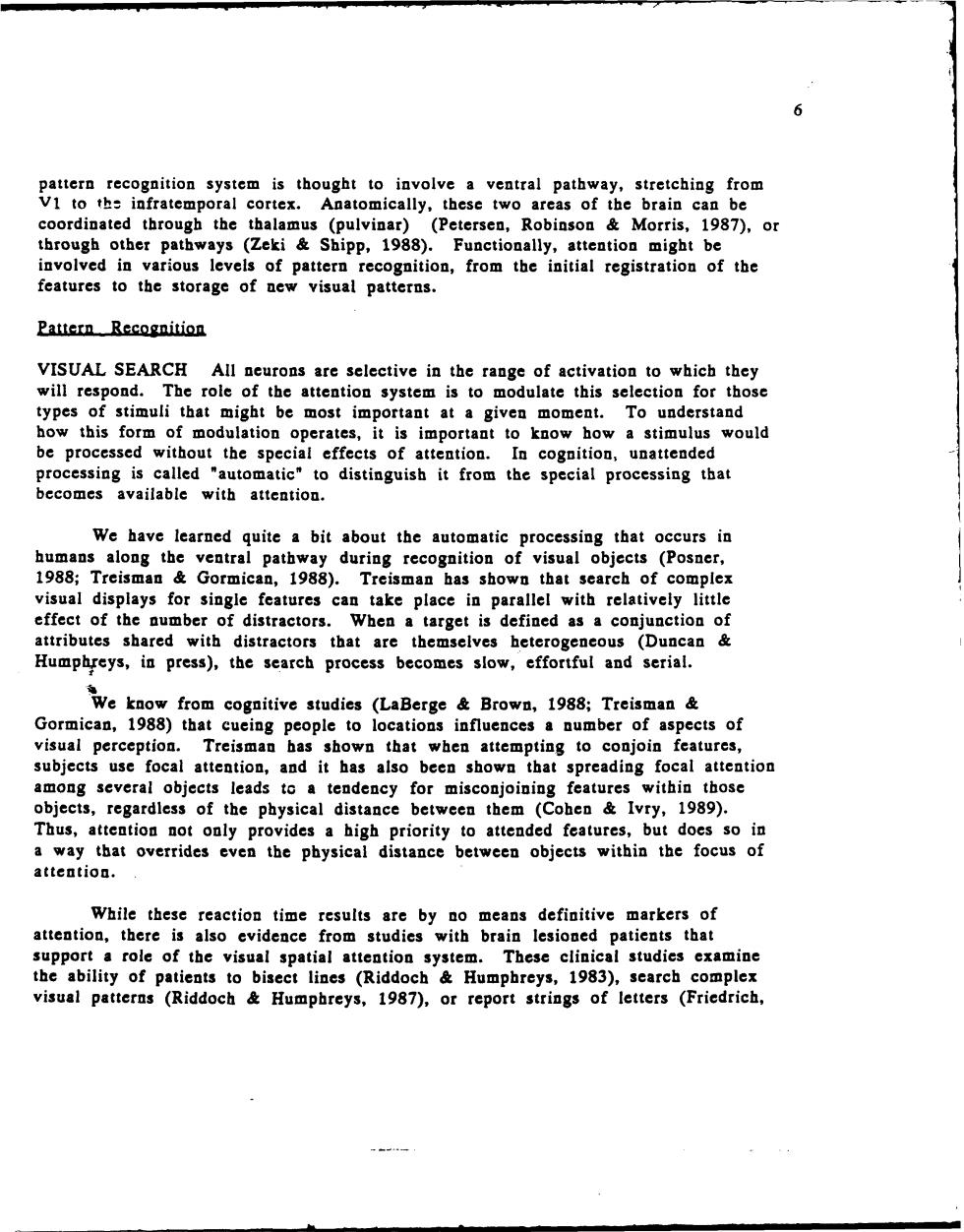正在加载图片...

6 ttern reco is thou thes coordinated through the thalamus (pulvinar) (Peterser Robinson Mo 3,1987).or through other pathways (Zeki&Shipp 10只g1 Hh2aEoHo074oa2x22ae7CAm0nPR0A attention t be istration of the features to the storage of new visual patterns. Pattern recognition ARou All neurons are selectve in the range of activation to will respond.The role of the att is to m dulate this selection for those might be most imp nt To understand it is im how a stim ulus would be processed without the special effects of att In c nition,unattended 8ceGoengnedagomioantsiagahtoaac cial processing that We have learned quite a bit about the automatic processing that occurs in humans along the ventral patbway during recognition of visual objects (Posner 1988;Treisman Gormican,1988). Treisman has sho、 n that tearch of comnle visual displays for single features can take place in arallel with relatively little effect of the number of distract When a tar et is defined as a conjunction of attributes shared with distractors that are ther (Duncan Humphpeys,in press),the search process becomes slow,efforful and serial. We kaow from cognitive studies (LaBerge&Brown,198:Treisman Gormican,1988)that cu ple to locatic ces a number of aspects of visual perception. has shown that when attempting to e subjects use focal attention. and it has also beer sho hat spreading focal attention among several obiects leads to mis features within those obiects.r egardless of the ical distan .h y (Cohe &Iv ,1989). only pro t does so in a wav that de even the physical distance hin the focus of attenti a. While these reaction time results are by definitive eviden ies with of vis his att amine visual Riddo nes (Ri Humphreys,1987),or report strings of6 pattern recognition system is thought to involve a ventral pathway, stretching from V1 to th: infratemporal cortex. Anatomically, these two areas of the brain can be coordinated through the thalamus (pulvinar) (Petersen, Robinson & Morris, 1987), or through other pathways (Zeki & Shipp, 1988). Functionally, attention might be involved in various levels of pattern recognition, from the initial registration of the features to the storage of new visual patterns. Pattern Recoanition VISUAL SEARCH All neurons are selective in the range of activation to which they will respond. The role of the attention system is to modulate this selection for those types of stimuli that might be most important at a given moment. To understand how this form of modulation operates, it is important to know how a stimulus would be processed without the special effects of attention. In cognition, unattended processing is called "automatic" to distinguish it from the special processing that becomes available with attention. We have learned quite a bit about the automatic processing that occurs in humans along the ventral pathway during recognition of visual objects (Posner, 1988; Treisman & Gormican, 1988). Treisman has shown that search of complex visual displays for single features can take place in parallel with relatively little effect of the number of distractors. When a target is defined as a conjunction of attributes shared with distractors that are themselves heterogeneous (Duncan & Humph reys, in press), the search process becomes slow, effortful and serial. We know from cognitive studies (LaBerge & Brown, 1988; Treisman & Gormican, 1988) that cueing people to locations influences a number of aspects of visual perception. Treisman has shown that when attempting to conjoin features, subjects use focal attention, and it has also been shown that spreading focal attention among several objects leads to a tendency for misconjoining features within those objects, regardless of the physical distance between them (Cohen & Ivry, 1989). Thus, attention not only provides a high priority to attended features, but does so in a way that overrides even the physical distance between objects within the focus of attention. While these reaction time results are by no means definitive markers of attention, there is also evidence from studies with brain lesioned patients that support a role of the visual spatial attention system. These clinical studies examine the ability of patients to bisect lines (Riddoch & Humphreys, 1983), search complex visual patterns (Riddoch & Humphreys, 1987), or report strings of letters (Friedrich